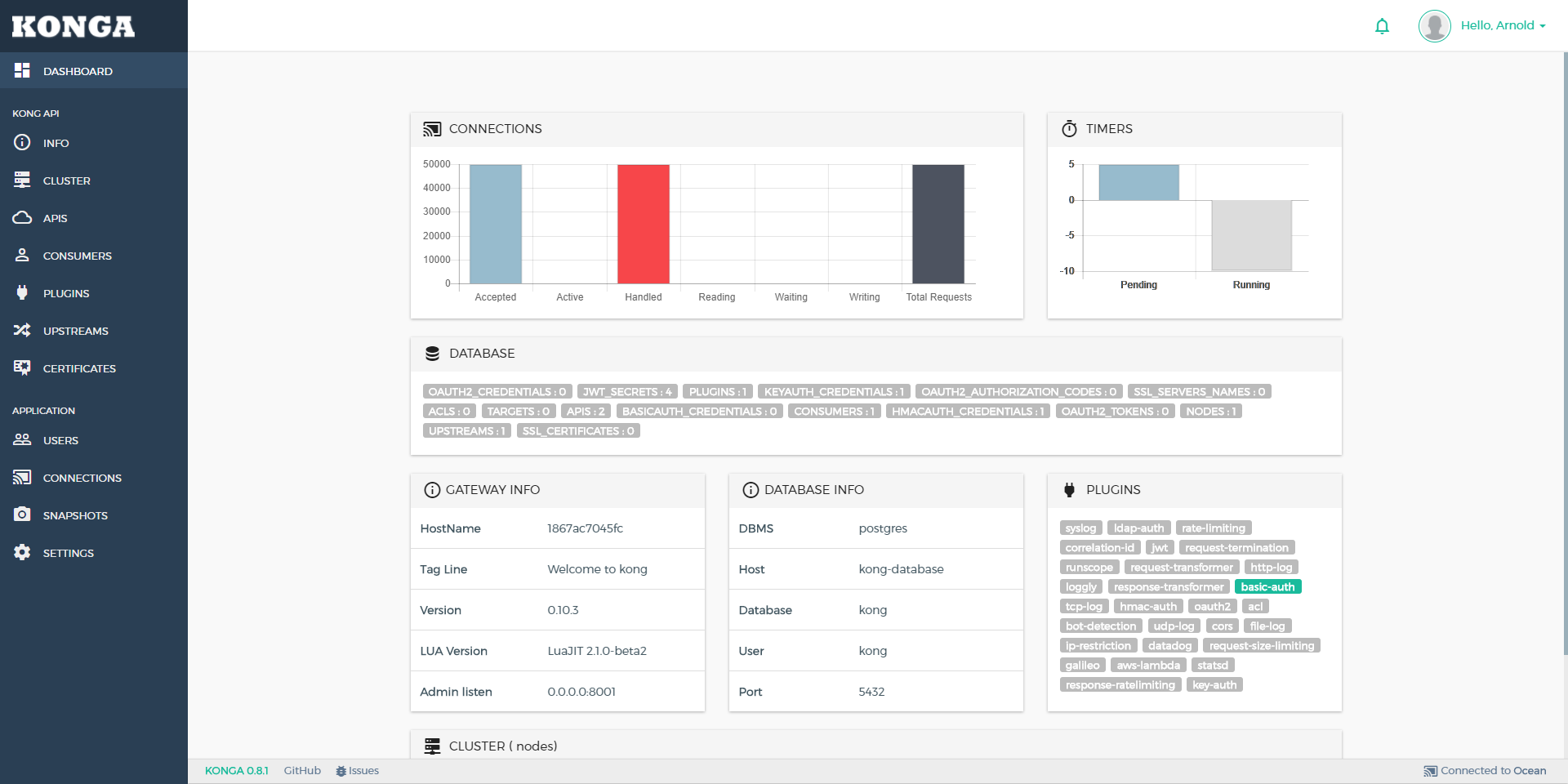More than just another GUI to KONG Admin API 

Konga is not an official app. No affiliation with Mashape.
Notice: Upgrade your Kong installations to v0.11.x so you can use Konga to it's full capacity. Support for older versions of Kong will be discontinued.
- Discussions & Support
- Features
- Compatibility
- Prerequisites
- Used libraries
- Installation
- Configuration
- Running Konga
- Upgrading
- FAQ
- More Kong related stuff
- License
If you need to discuss anything Konga related, we have a chatroom on Gitter:
- Manage all Kong Admin API Objects.
- Import Consumers from remote sources (Databases, files, APIs etc.).
- Manage multiple Kong Nodes.
- Backup, restore and migrate Kong Nodes using Snapshots.
- Monitor Node and API states using health checks.
- Email notifications.
- Multiple users.
- Easy database integration (MySQL, postgresSQL, MongoDB, SQL Server).
Konga is compatible with Kong 0.9.x,0.10.x,0.11.x
- A running Kong installation
- Nodejs
- Npm
- Sails.js, http://sailsjs.org/
- AngularJS, https://angularjs.org/
- Bootstrap, http://getbootstrap.com/
Install npm and node.js. Instructions can be found here.
Install bower, gulp and sails packages.
$ git clone https://github.com/pantsel/konga.git $ cd konga $ npm install
You can configure your application to use your environment specified settings.
There is an example configuration file on following path.
/config/local_example.js
Just copy this to /config/local.js and make necessary changes to it. Note that this
local.js file is in .gitignore so it won't go to VCS at any point.
Konga is bundled with It's own persistence mechanism for storing users and configuration.
A local persistent object store is used by default, which works great as a bundled, starter database (with the strict caveat that it is for non-production use only).
The application also supports some of the most popular databases out of the box:
- MySQL
- MongoDB
- PostgresSQL
- SQL Server
In order to use them, in your /config/local.js replace
models: {
connection: process.env.DB_ADAPTER || 'localDiskDb',
}
with
models: {
connection: process.env.DB_ADAPTER || 'the-name-of-adapter-you-wish-to-use', // 'mysql', 'mongo', 'sqlserver' or 'postgres'
}
See Sails adapters for further configuration
In case of MySQL, PostgresSQL or SQL Server adapters,
you will need to start the app in development mode the first time.
npm start
Then kill the process and start Konga as you would in production mode. Konga will not create the database or tables in production mode.
$ npm start
Konga GUI will be available at http://localhost:1337
$ npm run production
Konga GUI will be available at http://localhost:1337
The following instructions assume that you have a running Kong instance following the instructions from Kong's docker hub
$ docker pull pantsel/konga
$ docker run -p 1337:1337
--link kong:kong
--name konga
-e "NODE_ENV=production" \ // or "development" | defaults to 'development'
pantsel/konga
// As stated before, in case of 'postgres','sqlserver' or 'mysql' adapters,
// the app must be started in development mode the first time in order to be able to apply migrations.
// You can do that by bashing into Konga's container and running 'node app.js --dev'.
// You may also need to add an extra link that points to your database container.
$ docker run -p 1337:1337
--link kong:kong \
-e "DB_ADAPTER=the-name-of-the-adapter" \ // 'mongo','postgres','sqlserver' or 'mysql'
-e "DB_HOST=your-db-hostname" \
-e "DB_PORT=your-db-port" \ // Defaults to the default db port
-e "DB_USER=your-db-user" \ // Omit if not relevant
-e "DB_PASSWORD=your-db-password" \ // Omit if not relevant
-e "DB_DATABASE=your-db-name" \ // Defaults to 'konga_database'
-e "NODE_ENV=production" \ // or 'development' | defaults to 'development'
--name konga \
pantsel/konga
The GUI will be available at http://{your server's public ip}:1337
Login, go to settings -> new node and add http://kong:8001 for Kong Admin URL.
Admin login: admin | password: adminadminadmin
Demo user login: demo | password: demodemodemo
In some cases a newer version of Konga may introduce new db tables, collections or changes in schemas. The only thing you need to do is to start Konga in dev mode once so that the migrations will be applied. Then stop the app and run it again in production mode.
In some cases when running npm install, the bower dependencies are not installed properly.
You will need to cd into your project's root directory and install them manually by typing
$ npm run bower-deps
When a plugin property is an array, the input is handled by a chip component.
You will need to press enter after every value you type in
so that the component assigns it to an array index.
See issue #48 for reference.
See issue #40 for reference.
If you see this error while trying to run Konga, it means that konga has no write permissions to
it's default data dir /kongadata. You will just have to define the storage path yourself to
a directory Konga will have access permissions via the env var STORAGE_PATH.
Panagis Tselentis
The MIT License (MIT) ===================== Copyright (c) 2015 Panagis Tselentis THE SOFTWARE IS PROVIDED "AS IS", WITHOUT WARRANTY OF ANY KIND, EXPRESS OR IMPLIED, INCLUDING BUT NOT LIMITED TO THE WARRANTIES OF MERCHANTABILITY, FITNESS FOR A PARTICULAR PURPOSE AND NONINFRINGEMENT. IN NO EVENT SHALL THE AUTHORS OR COPYRIGHT HOLDERS BE LIABLE FOR ANY CLAIM, DAMAGES OR OTHER LIABILITY, WHETHER IN AN ACTION OF CONTRACT, TORT OR OTHERWISE, ARISING FROM, OUT OF OR IN CONNECTION WITH THE SOFTWARE OR THE USE OR OTHER DEALINGS IN THE SOFTWARE.


